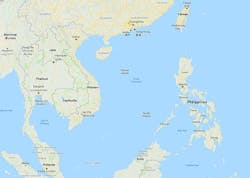Why is Navy weapons development moving so quickly? Just look to the South China Sea
The armed forces of China are building military bases on contested islands in international waters of the South China Sea, and have deployed anti-ship cruise missiles on at least one of these islands. It's clear from the military buildup in the region that China has the ability to dominate the South China Sea, and the U.S. Navy is about the only thing that could stand in its way.
So why should we care about the South China Sea, and why should China's emerging military superiority in the region be a concern?
The South China Sea borders on China, Taiwan, the Philippines, Malaysia, Indonesia, and Vietnam. China has the longest coastline on this waterway -- about 9,000 miles -- so it's understandable that China has legitimate territorial concerns.
Related: The U.S. Navy wants fast-tracked new weapons to counter Russia and China
At the same time, however, the South China Sea has tremendous international strategic and commercial significance aside from China. At least one-third of the world's shipping passes through it each year, carrying more than $3 trillion in trade. The South China Sea also has important fisheries, and may hold large oil and gas reserves.
Much of the world depends on free access to the South China Sea for maritime commerce. While China has not indicated a desire to limit access to and through the waterway, such a move cannot be ruled out -- given today's volatile climate in international relations.
China’s military has test-fired a YJ-62 anti-ship missile from Woody Island in the Paracel Islands in the northern part of the South China Sea. The island is northwest of the disputed Spratly Islands, east of Vietnam, and southeast of China's Hainan Island.
The YJ-62 is a subsonic cruise missile with a 463-pound explosive warhead. The missile can attack ships from as low as 23 feet above the water and can cover distances from its launch site as far out as 250 miles.
In itself, one YJ-62 missile battery in the Paracel Islands is not a dire threat to international shipping, yet add a YJ-62 battery in the disputed Spratly Islands, and China would be in a position to seal-off the South China Sea from Vietnam to the Philippines.
Would the world's tanker and cargo ships attempt to transit through the South China Sea if under threat from China's land-, sea-, and air-based anti-ship cruise missiles? I wouldn't think so. Is this a likelihood today? Not really. But is it a possibility? Certainly yes.
So what if the worst happens and China effectively decides to close the South China Sea to international military and commercial shipping? Certainly much of that ship traffic could be rerouted south of Indonesia and north of Australia, but such a move causes its own problems.
Now consider the energy potential of the South China Sea with its oil and gas deposits. What chance does a Brunei, Malaysia, Philippines, Vietnam, or Taiwan have in an equitable sharing of regional energy resources with a China that dominates the region militarily?
Realistically, the only force that could level the playing field is the U.S. Navy. Is it any wonder, then, that Navy leaders urgently are developing new technologies in laser weapons, hypersonic missiles, fast attack submarines, emergency communications, radar-evading stealth, and advanced combat aircraft, just to name a few?
I have to admit that the South China Sea is one of the things that keeps me awake at night. The military forces of China and the U.S. are building up there quickly, and things easily could get out of hand. Put simply, if there's a World War III, it's likely to start in the South China Sea.
Ready to make a purchase? Search the Military & Aerospace Electronics Buyer's Guide for companies, new products, press releases, and videos
